“Fats” Waller – High-Calorie Talent Makes Full-Flavor Jazz
Is there a jazz performer from before WWII who is both better known and yet less familiar to modern listeners than Fats Waller? Let us have a look (and a listen) to this larger-than-life combination of talent and personality who is responsible for many of the songs jazz fans still listen to today.
Thomas Wright Waller was born May 21, 1904 in the Harlem section of New York City. During the following 39 years he would go from child keyboard prodigy playing the organ in the Abyssinian Baptist Church (where his father was a deacon) to the pinnacle of fame as a musician and entertainer. From Vaudeville to Broadway, from records to radio and from nightclubs to the movies, if there was a keyboard or a song involved, Waller was there, large and in charge.
Young Waller fell under the spell of jazz at a young age – before it was called jazz, really. Around the time of WWI, “stride piano” sprouted and blossomed in New York as a sort of a musical bridge between ragtime and jazz. Two of the men who popularized the style – James P. Johnson and Willie “the Lion” Smith – took the youth under their musical wings, and put him on the path to become probably the most famous of the stride players. Waller quit high school after just one semester to play the organ in a movie theater and was playing at Harlem rent parties and making records by the time he was 18.
Unlike more modern piano styles, stride used the entire keyboard. The melody and other flourishes were for the right hand while the left hand bounced back and forth between low and lower to set a strong rhythm that made both bass and drums unnecessary. Waller grew into a big man – well over 300 pounds (hence the nickname “Fats”) and his large hands gave him the physical ability to span 10 keys and throw in some chords with that powerful, thumping left paw.
Waller would play anywhere that paid and even earned cash making piano rolls for the player pianos that were the high-end home entertainment systems of the day. In addition to playing for a series of bands in the 20’s (some of them quite well known, like McKinney’s Cotton Pickers), Waller recorded a number of piano solo records, like this great 1929 example of the stride style, “A Handful Of Keys”. I count it as one of the great tragedies of life that this performance came too early for modern recording techniques. I can only imagine the way those pounding low notes could have come through. Did I mention that I love piano players with a strong left?
Side note – it will surprise nobody who has ever heard the early piano work of the great Count Basie to learn that some of his early lessons on the keyboard came courtesy of Fats, who played piano and organ at a theater near Basie’s boyhood home in Red Bank, New Jersey. Another side note is that Waller was also proficient on the pipe organ and is considered the first player of jazz organ based some recordings from the late 20’s.
Fats Waller was not just a guy who played the piano, great as he may have been. He was also one of the most prodigious songwriters that ever there was. As early as 1929 he was responsible for hit songs in Broadway shows like Connie’s Hot Chocolates, among which was the still-performed Ain’t Misbehavin’. (Listen here for an early version if you can’t get enough of Fats’ piano from the late 20’s). Waller is officially credited with over 400 copyrighted tunes and is believed to have written at least double that number when counting songs he sold to others when he was drunk or when he needed money – which was often, given his prodigious appetites for almost everything. It is believed that standards like “On The Sunny Side of the Street” and “I Can’t Give You Anything But Love” were among the hundreds of songs Waller wrote that were published above others’ names.
By 1943 he became the first African-American to write the musical score a mainstream Broadway Musical, the fairly successful “Early to Bed”. Sadly, that show (which ran for a year) had the misfortune to run during a musicians’ recording strike so it was never recorded, and it also had the misfortune of an introduction the same year as Rogers & Hammerstein’s game-changing “Oklahoma”. A few of the songs from “Early to Bed” were published, but the original conductor’s score has been long lost.
But let’s get back to music we can still listen to. In 1932 he was convinced to move to Cincinnati, Ohio to do a show for WLW radio called “Fats Waller’s Rhythm Club”. The show was a success and earned him enough guest spots on other big shows that he was back in New York by 1934 doing the show nationally for CBS radio. That show spawned a sort of studio band he called “Fats Waller and his Rhythm”, which was signed by Victor Records as the label’s featured jazz act after George Gershwin heard Waller playing and singing at a party.
With this six-ish piece group (which included several different musicians over the years) Waller recorded around 400 sides between 1934 and 1942, often pounded out in batches of as many as ten records in a single session, and usually with little to no practice. Many of them were solid hits, like “Truckin'” from August of 1935. Some of us of a certain age think of “Keep On Truckin'” as a phrase from the early 1970’s, but Fats Waller made “Truckin'” a thing four decades earlier. One of his musicians recalled Waller as the most relaxed man he had ever seen in a recording studio, something that made the rest of the players relax too.
Trying to pick out a single Waller record of the mid 1930’s is an impossible task, so let’s throw in another: “It’s a Sin to Tell a Lie”, from 1936. I dare anyone to try making it through this record without a breaking into a big fat smile. Have I mentioned how much I love that left hand? These records show how Waller hit the trifecta: Not only was he a great musician and a great songwriter, but he was also an entertainer of the first order who could turn some really thin material into gold. Murray Horwitz, one of the men behind the 1978 show devoted to Waller’s music (“Ain’t Misbehavin'”) noted that no musician ever made so many people laugh and no comic was ever so gifted at music.
Lest you think that Fats Waller’s sole performance mode was his comic mugging, try this 1941 recording of “Winter Weather”, which shows how Fats could turn out first-rate, straight-ahead music that was really lovely. I recall reading on some album liner notes somewhere that the more Waller respected a song, the more likely he was to play it with dignity instead of with comedy. He must have respected this one quite a bit, and with good reason.
Waller was, unfortunately, a victim of his own success at comedic performance – a success that sometimes got in the way of his recognition as one of the greatest musical talents America has produced. He sought to change that in 1942 when he was featured in a performance at New York’s Carnegie Hall. Sadly, there were two problems that kept the show from being a hit. One was Fats himself – he had spent the day in a celebratory mood, and consumed far too much liquor, even by his own lofty standards. The result was an uneven performance which included a second act that some called a disaster. The other problem was the public – Fats went into the show to feature his skills as a musician, but the audience wanted him to be the comic singer they knew and loved. Thus, the show would probably not have been well-received even if Fats had been in top form. A 22-minute segment of that show (which includes Waller singing some blues) was captured but never issued, and can be heard here, for those who want a deeper dive.
Waller began to get movie roles as early as 1935 and did a series of “Soundies” in 1941, including this version of another of his best known compositions, “Honeysuckle Rose”. These Soundies, which predated the music videos that ruled the 80’s, are a great way to capture the full spectrum of Waller’s showmanship – which included one of the most expressive faces in the history of entertainment. If there was ever a jazz performer simply made for the movies, it was Waller, whose outsized personality was every bit as much visual as it was aural.
Fats Waller was at the peak of his career when he was offered a prominent role in the 1943 20th Century-Fox film “Stormy Weather”, one of the few big-budget films that showcased top black entertainers of the day, a film which also included Lena Horne, Cab Calloway, Bill “Bojangles” Robinson and The Nicholas Brothers.
It was fitting, of course, that the film featured Waller’s signature tune “Ain’t Misbehavin'”. Waller recorded this tune many times over his career, and no two versions were the same. Sadly, this would prove to be his last performance caught on film.
The history of jazz is full of performers who hang around long enough to go out of style and eventually come back, and others who go into a sad decline as their careers (and lives) swirl the drain. Waller is one of the rare ones who went out at his peak. In a long-ago documentary (Part 1 here), Waller’s son described his father’s life as one big party that could only be interrupted by music. After many years of too much eating and drinking, too many women, too much work, too much fun and not enough rest, Waller contracted pneumonia during a stand in a California nightclub shortly after finishing “Stormy Weather”. It was on the train back to New York that his condition worsened. The train was in Kansas City on December 15, 1943 when Fats Waller died at the age of 39 .
Among early jazz greats, it is usually Duke Ellington who is considered the gold standard for raw, musical talent. That Ellington was talented is without doubt. However, I would suggest that Fats Waller may have been Ellington’s equal. Had Waller possessed a more serious nature and more self-discipline, he might have eclipsed Ellington as both writer and performer. But then with a more serious nature and more self-discipline, he wouldn’t have been Fats Waller, either.
Media Credits:
All musical/film selections as credited on the YouTube pages embedded or linked
All images are promotional photos or published material over fifty years old and not protected by copyright
Further Reading:

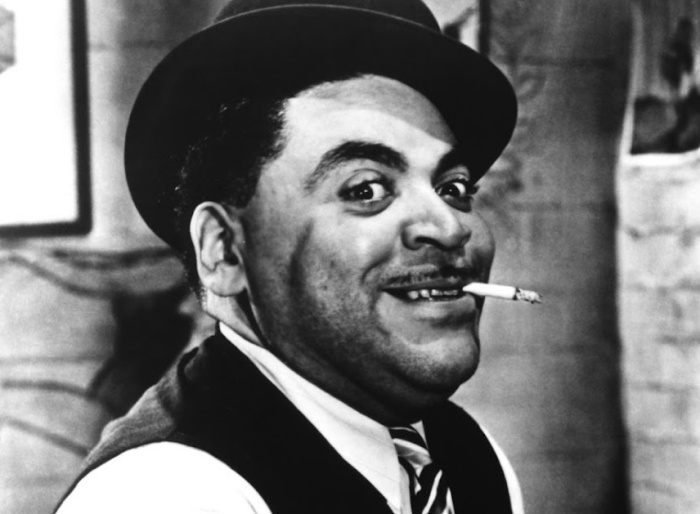
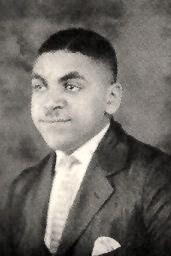

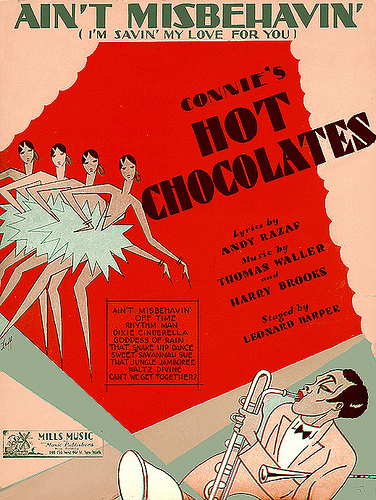
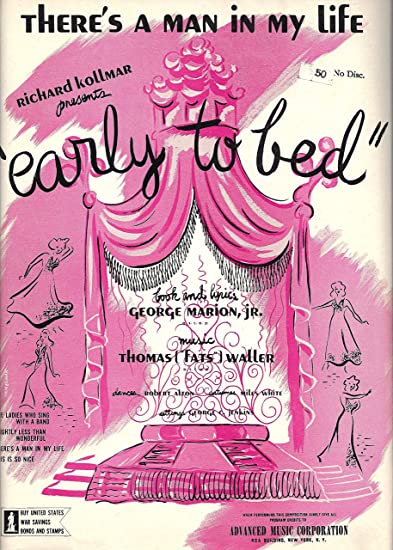

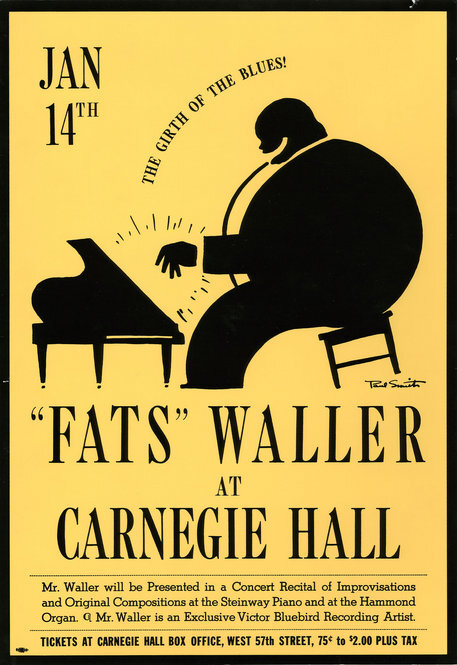
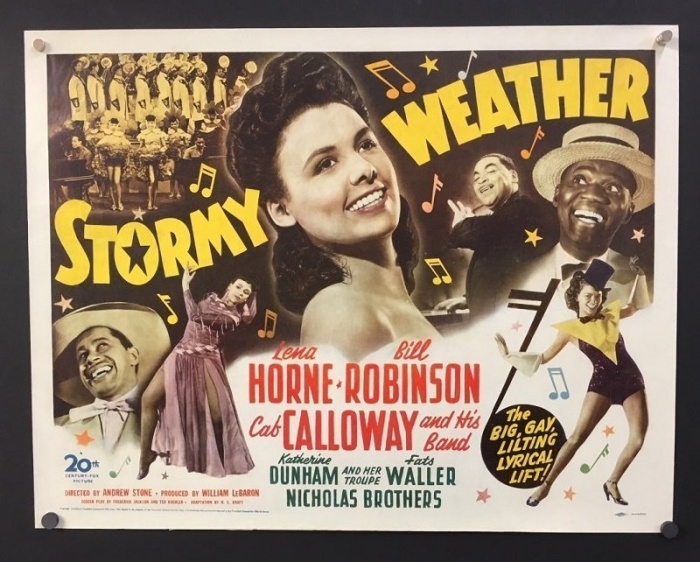
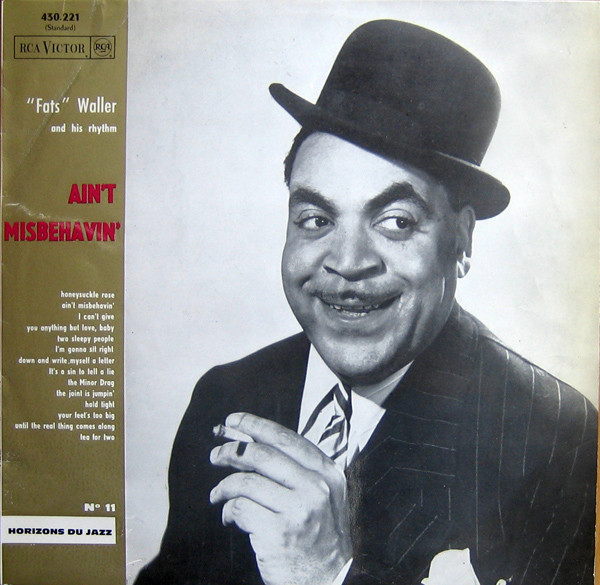
J.P., another great entry! Love me some “Fats”, but unaware of his extensive writing career!
LikeLiked by 1 person
I have finally come to the conclusion that Waller was very much like Louis Armstrong in his performances. He combined a peerless ability on his instrument with the heart of an entertainer. Both were known for themselves rather than as part of a group and both kind of floated above fads and styles by sticking with their own things – things that seemed to always be current, though not edgy. The big difference was that Armstrong came from nothing and tended towards stability while Waller came from a stable home life and rebelled against it, living like he had an allergy to responsibility.
I also made a Duke Ellington comparison in the writing, but there was a big difference. Ellington wrote more as an artist and explored new things while Waller wrote as a populist and churned out good, catchy tunes by the gross. The people who have studied and written about jazz have been much more attuned to Duke’s style than to that of Fats, which may explain why Waller’s prodigious writing is so under-appreciated today.
LikeLike
I knew the name, but I never heard any of his music or that he wrote so prolifically. I got a real kick out of watching his fingers and his eyebrows during the movie clips.
LikeLiked by 1 person
He was indeed a showman. I read someone who described the eyebrows as always indicating that there was a hidden joke inside the joke he had just told – often one that was too racy for public consumption.
I made another discovery – You being in Canada, I don’t know if you ever got broadcasts of the American PBS show “This Old House” – a home restoration show that got started in the early 70s and ran for decades. I never knew that the theme song they used for about 20 years was a Fats Waller recording from the 30s called Louisiana Fairytale.
LikeLike
Great clips. Learned a lot. Cool post.
LikeLiked by 1 person
I learned a lot too! There is so much of his stuff out there that I had not heard. A surprise I mentioned in another comment was that a 1935 Waller record, “Louisiana Fairytale”, was the theme song for the PBS show This Old House for many years. I had never known that was where they got that music.
LikeLike
An interesting guy and musical history, but dead at 39…what a shame.
LikeLiked by 1 person
I know – another short life with a high-intensity flame. Nothing in my research said so, but I have to wonder how much longer he could have kept on at a high level had the pneumonia not gotten him when it did. The man drank A LOT, and that always takes its toll.
LikeLiked by 1 person
As a piano player myself I am in awe of Waller’s ability to play without looking at the keyboard. In the “Ain’t Misbehavin'” video I was listening for mistakes and just couldn’t hear any as his eyes were everywhere but the piano. He could’ve been blind and would’ve been just as talented. Also, in the audio clip of “Ain’t Misbehavin'”, I love how the left-hand walks up the keyboard one prominent note at a time. He probably used his pointer finger when he did that to add flair to his playing. Finally, any idea if “Stormy Weather” included the beautiful arrangement by Etta James? After “At Last”, it’s my favorite song of hers. Thanks for another educational, entertaining post, JP (and I never knew there was a formal bridge between ragtime and jazz). The clips are wonderful.
LikeLiked by 1 person
It wouldn’t surprise me that those films were synched with sound recorded separately, but then again it wouldn’t surprise me that Waller was able to do just that, given his skills.
I know that Lena Horne sung Stormy Weather in the film, but I suspect that it would have been a different arrangement, much more 1943 than the late 50’s style of James’ version.
It occurred to me that stride was a kind of bridge between ragtime and jazz, and that Waller was kind of a bridge between early jazz piano and more modern styles. There are certain performers who are so constantly entertaining on their instruments that I never get tired of listening to them bring new and different twists to a familiar style. Waller has to be counted among that number. His singing is fun, but he really was a master of that keyboard who could make it do almost anything. I read that someone back in his day called him the black Horowitz. He did in fact have a little bit of classical training in his youth.
LikeLike
Pingback: Tea For Two – Some Classic Takes On A Perennial Jazz Favorite | J. P.'s Blog